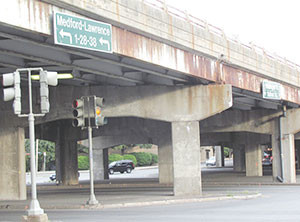
— Photo by Bobbie Toner
By Shira Laucharoen
Somerville Wire
For too long, McGrath Highway, known for slicing through neighborhoods and creating unsafe spaces, has been “a scar on the Somerville landscape,” according to Rep. Mike Connolly. Now, the Massachusetts Department of Transportation is finally moving ahead with plans to revamp the highway and take its elevated section down. The McGrath Highway Resurfacing Project will reduce the number of automobile lanes to four and include bike paths. However, Connolly and other political leaders are calling for other critical safety measures to be included in the plan.
“I first became active in our community, in Somerville and Cambridge, around the 2011-12 time period, and from the very beginning, I’ve recognized that this McGrath Highway is really just an atrocity, in terms of how it walls off the East Somerville neighborhood from the rest of the city. It really is a relic of that urban renewal time, when people thought that if we bulldoze neighborhoods and run elevated highways through them, somehow we will be doing a public service,” said Connolly. “It functionally goes against any notion of good urban design or transit equity, and practically speaking, the actual condition of the roadway itself is really deplorable.”
The highway is in need of repair work, including new surfaces, sign replacements, and renovations made to the deteriorating railings and sidewalks. Not only is it in poor condition, but it walls off communities that have been historically underserved. Pedestrians hoping to traverse the neighborhood will immediately find themselves obstructed by the design of the highway. Connolly said that the highway was never really created to serve Somerville residents but was created so that people living in the suburbs could get through to Boston.
“It’s a very physical impediment to the neighborhood,” said Connolly. “In many parts of East Somerville, if you want to get to another part of Somerville, you can’t just head in that direction. You really have to circumnavigate this barrier, this large wall, that walls off the East Somerville neighborhood in multiple directions. The air pollution, the lack of inviting street scape, also degrade the quality of life for East Somerville residents. East Somerville has traditionally been home to immigrant families, home to working class families, and I don’t think it was an accident to wall the parts of Somerville, when they were building the McGrath Highway. I think we can appreciate that this neighborhood was chosen probably because it was among the most marginalized in the city, at the time, and continues to be.”
MassDOT will be moving ahead with the McGrath Highway Resurfacing Project, much to the relief of advocates, while the Grounding McGrath Project will advance to the 25% design phase. Grounding McGrath includes the decision to remove the McCarthy Overpass and create a multimodal boulevard. Connolly and other representatives— including Sen. Pat Jehlen and Reps. Christine Barber and Erika Uyterhoeven—wrote a letter to MassDOT stating that they still have concerns about the highway. There must be physical barriers between bike lanes and automobile lanes, they wrote, otherwise the safety of bikers will be seriously compromised. They also called for a reduction in speed limit and a narrowing of the ramp that runs up to the highway between Washington Street and Cross Street. MassDOT declined to comment on the topic for this article. Steven Miller, a founding board member of LivableStreets Alliance, has been vocal about the vision that he and others have for the highway.
“The vision is turning this wall into a permeable transportation road, making it a street and part of the community, rather than a wall that separates the community,” said Miller. “That involves having crosswalks, it requires slowing down the cars, it requires allowing space for other modes, whether it be walking along the sidewalk or riding your bike. It means greening it, putting in trees or grass, something that makes it feel like other than a concrete wall. A lot of these things are implied in the plan, but it’s going to require continued vigilance on the part of City government and community groups to make sure that the best of the possibilities that the current design allows are actually implemented.”
Steven Nutter, a Somerville resident and executive director of Green Cambridge, has been advocating for changes to the McGrath Highway for some time and even originally called for its complete removal. He is satisfied with the plans MassDOT has made but acknowledges that improvements are still needed, and he will continue to speak out about them.
“It’s a relic of our transportation past,” said Nutter. “It does nothing but divide the city and make it difficult to travel around. The vision in 2011 was a little bit radical, and it’s much more palatable now. To have this work of the ‘road diet’ come out of MassDOT as being the thing that they’re going to do is just amazing. I want to push harder and be the advocate to rebuild that neighborhood.” He added, “The biggest thing is equity. Not everyone has a car, and a car is a burden. Most of the traffic in Somerville is not people from Somerville. As long as we have a system that prioritizes automobiles over people, we will always continue inequities in how we use land, how many trees we can plant, how much affordable housing we can have, all these pieces that an automobile-centric plan takes away from.”

Shira Laucharoen is assistant director of the Boston Institute for Nonprofit Journalism and assistant editor and staff reporter of the Somerville Wire. She also writes for Sampan newspaper and The Somerville Times.

 https://www.portersquarebooks.com/
https://www.portersquarebooks.com/













“…the actual condition of the roadway itself is really deplorable.”
Has Rep. Connolly looked around the rest of Somerville lately? The same can be said about just about any other roadway in the city. The sidewalks too.
It’s a shame our representatives don’t realize that not every single road needs to be 20 mph, with protected bike lines and pedestrian crossing every 200 feet. McGrath is a key artery for getting cars and trucks from Cambridge and downtown to Medford and Everett. What is the plan for these vehicles to get across Somerville in the future? I can’t seem to find an explanation other than proponents of such designs imagine everybody will just walk or bike or take public transit. Unfortunately, it seems to me like we’re simply on the path to a traffic nightmare.
What is missing from all of these road change narratives is funding. At what point do we start charging bicyclists for their fair share of road costs?
The thing to consider is it is a main road for traffic to the hospitals in Boston and used by many ambulance services. So that in this day and age has to be given some consideration. And what happens when traffic is returned to normal? And some of us do remember what a mess it was before all this was built.